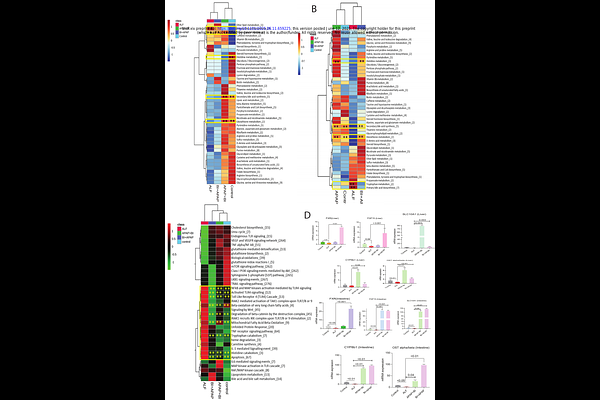Chenodeoxycholic Acid Modulation via Bacteroides intestinalis AM1 underscores a Novel Approach in Acute Liver Failure

Chenodeoxycholic Acid Modulation via Bacteroides intestinalis AM1 underscores a Novel Approach in Acute Liver Failure
PANDEY, S.; Sharma, N.; Sharma, N.; Bhat, S. H.; Sharma, V.; Kushwaha, M.; Kumar, A.; Magar, Y.; Gupta, A.; Mathew, B.; Tripathi, G.; Bindal, V.; Yadav, S.; Yadav, M.; Parasar, A.; Sharma, S.; Bihari, C.; Katyal, A.; Maiwall, R.; Sarin, S. K.; Maras, J. S.
AbstractBackground: Acute liver failure (ALF) is associated with rapid and progressive hepatocellular injury, and severe metabolic-microbial derangements. We investigated early metabolic markers of non-survival, and a potential microbial intervention using Bacteroides intestinalis-AM1, to improve outcomes in ALF. Method: Plasma metabolomics and meta-proteomics were performed in 40 ALF patients and 5 healthy controls (training cohort). A non-survival marker panel was identified and validated in 270 ALF patients (test cohort) using high resolution mass spectrometry and machine learning. It was functionally validated in acetaminophen-induced ALF mouse model. B. intestinalis-AM1 was used to study alteration of gut bacteria and amelioration of liver injury. Results: ALF non-survivors showed a distinct metabolomic signature with elevated primary bile acids {chenodeoxycholic acid (CDCA), cholic acid (CA)}, tryptophan, tyrosine, and enrichment of pathways linked to inflammation, cell death, and stress response (p<0.01, FDR<0.01, FC>1.5). Non-survivors had higher alpha/beta diversity (p<0.05) with increase in Proteobacteria, Firmicutes, Actinobacteria (p<0.05); functionally associated with energy, amino acid and xenobiotic metabolism (p<0.05). A gut microbiota derangement in converting primary to secondary bile acids was evident as CDCA and cytotoxic metabolites (4-(2-Amino phenyl)-2,4-dioxobutanoate, L-Tyrosine) were higher. Elevated CDCA (logFC>10) levels correlated with mortality in ALF patients as well as in mouse model. In the later, administration of B. intestinalis-AM1 bacteria, (10^9) reduced CDCA and CA levels by enhancing FXR, FGF15, SLC10A1 gene expression, attenuating inflammation (IL-1beta, TLR4-signalling), necroptosis, and modulating glutathione(oxidative-repair), tryptophan(inflammation), and histidine (tissue repair) metabolism. Conclusion: High levels of chenodeoxycholic acid (CDCA) represent a poor prognostic indicator in ALF patients. B. intestinalis-AM1, a primary-to-secondary bile acid converter, effectively reduce CDCA levels, activated FXR, reduced inflammation and protected hepatocytes, highlighting its therapeutic potential in ALF.